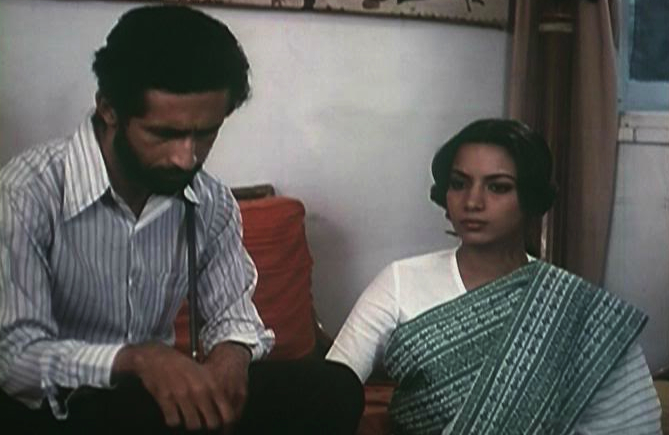Kavita (Shabana Azmi) is a young widow, who prefers to live in seclusion after her husband’s death. She gets drawn into working at the Navjeevan Blind Institute near her home, by a series of chance meetings with the blind principal, Anirudh Parmar (Naseeruddin Shah). Both Anirudh and Kavita live in their own worlds of darkness, and must learn to understand each other’s worlds and their complexities before they can make their relationship work…
Strangely, Sparsh does not have great visuals, or an interesting sound track, or even memorable music. Yet, what allows it to hold its own decades after it’s making, is a sensitive script and masterful performances. From the first scene itself, in the corridor of the Blind Institute, where a 8 year old blind boy, Ram Pyaare Saxena, is reading his lessons aloud to be interrupted by his principal, Anirudh Parmar, it is clear that here is a director (Sai Paranjpye), who not only knows the story she is telling us but also understands why she is telling it to us.
The script builds up its main narrative through setting up a series of small narratives, that come together to not only move the story forward in time, but also in its emotional and dramatic graph. One of the most important stories within the film is that underlining the need for more books in Braille. It unfolds through several plot points. A child, Ram Pyaare reading his text book alone at night, two older children worried about their Braille text books not arriving in time for their exam, Ram Pyaare’s sighted friend, Paplu reading him a favourite story, come at a time when Kavita and Anirudh are just getting to know each other. One of the best romantic scenes I have seen in films is when Kavita and Anirudh are sitting in a garden, and he asks her if she is beautiful. She describes her brown eyes, her thick hair, her fair skin, which are considered beautiful by others. He says they are useless to him. He finds her beautiful because her hair and her body smell so nice, her voice is sweet like the sound of a guitar, and her touch is so soft. The chemistry, the intimacy of the scene sets the screen on fire.
But when Anirudh breaks his engagement with her, Kavita’s concern that the children do not read in their spare time, fetches her a verbal lashing from Anirudh. He tells her that the children don’t read because there are barely any story books published in Braille, that even blind children need fairy tales and taunting her that she herself has not bothered to study Braille despite being in the Institute for 6 months. She starts studying Braille secretly but unable to cope with her presence every day, he asks her to leave the Institute. When she refuses, he decides to leave. At which point, she gives up. Anirudh’s secretary, Jagdish, delivers a letter to Anirudh, written by Kavita in Braille. Anirudh hears Ram Pyaare reading a story to Paplu. Paplu tells him that Kavita has transcribed six stories in Braille for the children. And Anirudh realizes that Kavita is a part of his world, he seeks her out again.
Within the story of the relationship between Kavita and Anirudh and their different worlds of darkness, Sai Paranjpye tells us little stories of the blind children and their needs. Their desire to play cricket, put up plays, the rivalry that Paplu feels for his blind friend, Ram Pyaare who gets more attention from his beloved teacher, Kavita, just because he is blind, making Paplu want to be blind too. Yet, the issue of blindness is never hammered through but we learn about it by being led gently into their world. We learn slowly like Kavita does, not to pity, but to love.
While Naseeruddin Shah is outstanding in his National Award winning role as the blind, touchy, hypersensitive Anirudh, Shabana is the perfect foil with her comparatively simple, warm, but emotionally vulnerable Kavita. Mohan Gokhale as Jagdish with his own blossoming romance, Om Puri in a miniscule role as Dube-ji, the arts teacher with an ill wife who has been discontented in her marriage with a blind man, and Sudha Chopra as Kavita’s childhood friend, Manju who wants Kavita to come out of her self-imposed seclusion and start living again, are all characters etched through subtle gestures and expressions. What helps of course is that the characters, howsoever small, have a definite place in the narrative, they are not there merely to fill up the scenery. In the same way, the blind school is an intrinsic part of the story, not just a backdrop. Therefore it comes alive. The biggest proof of the director’s ease with the story and the location comes in the performances of the children, all of them blind, except Paplu.
Sparsh is a particular story told in a particular way, very rooted in its milieu and therefore it still works and moves you. It brings back a time where films were stories and not projects.
Hindi, Drama, Color


